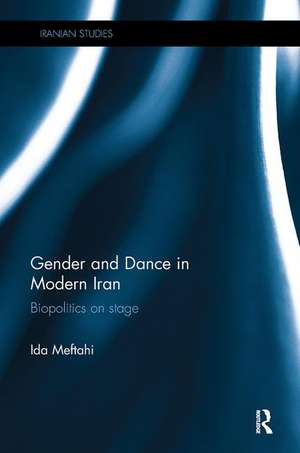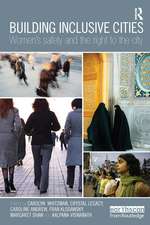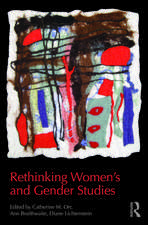Gender and Dance in Modern Iran: Biopolitics on stage: Iranian Studies
Autor Ida Meftahien Limba Engleză Paperback – 13 dec 2017
Engaging with a range of methodological and historiographical methods, including postcolonial, performance, and feminist studies, this book is a valuable resource for students and scholars of Middle East history and Iranian studies, as well as gender studies and dance and performance studies.
| Toate formatele și edițiile | Preț | Express |
|---|---|---|
| Paperback (1) | 429.62 lei 6-8 săpt. | |
| Taylor & Francis – 13 dec 2017 | 429.62 lei 6-8 săpt. | |
| Hardback (1) | 1054.71 lei 6-8 săpt. | |
| Taylor & Francis – 23 mar 2016 | 1054.71 lei 6-8 săpt. |
Din seria Iranian Studies
-
 Preț: 154.25 lei
Preț: 154.25 lei -
 Preț: 310.03 lei
Preț: 310.03 lei - 18%
 Preț: 1053.92 lei
Preț: 1053.92 lei - 18%
 Preț: 1108.37 lei
Preț: 1108.37 lei - 25%
 Preț: 823.63 lei
Preț: 823.63 lei - 25%
 Preț: 823.99 lei
Preț: 823.99 lei -
 Preț: 449.41 lei
Preț: 449.41 lei - 18%
 Preț: 1068.18 lei
Preț: 1068.18 lei - 18%
 Preț: 997.90 lei
Preț: 997.90 lei -
 Preț: 389.38 lei
Preț: 389.38 lei - 18%
 Preț: 1055.51 lei
Preț: 1055.51 lei - 12%
 Preț: 299.52 lei
Preț: 299.52 lei -
 Preț: 442.68 lei
Preț: 442.68 lei - 18%
 Preț: 1059.84 lei
Preț: 1059.84 lei - 26%
 Preț: 848.57 lei
Preț: 848.57 lei - 25%
 Preț: 770.09 lei
Preț: 770.09 lei -
 Preț: 341.55 lei
Preț: 341.55 lei - 18%
 Preț: 1165.97 lei
Preț: 1165.97 lei -
 Preț: 437.13 lei
Preț: 437.13 lei - 18%
 Preț: 1168.76 lei
Preț: 1168.76 lei -
 Preț: 436.14 lei
Preț: 436.14 lei - 18%
 Preț: 1117.07 lei
Preț: 1117.07 lei -
 Preț: 478.86 lei
Preț: 478.86 lei - 25%
 Preț: 570.60 lei
Preț: 570.60 lei - 18%
 Preț: 1114.70 lei
Preț: 1114.70 lei - 26%
 Preț: 822.01 lei
Preț: 822.01 lei - 18%
 Preț: 1000.27 lei
Preț: 1000.27 lei - 18%
 Preț: 1060.52 lei
Preț: 1060.52 lei -
 Preț: 412.70 lei
Preț: 412.70 lei - 18%
 Preț: 1054.71 lei
Preț: 1054.71 lei - 22%
 Preț: 328.20 lei
Preț: 328.20 lei -
 Preț: 430.94 lei
Preț: 430.94 lei - 18%
 Preț: 1055.51 lei
Preț: 1055.51 lei - 18%
 Preț: 1002.63 lei
Preț: 1002.63 lei - 25%
 Preț: 685.71 lei
Preț: 685.71 lei - 18%
 Preț: 1067.14 lei
Preț: 1067.14 lei - 18%
 Preț: 1118.65 lei
Preț: 1118.65 lei - 18%
 Preț: 1054.75 lei
Preț: 1054.75 lei
Preț: 429.62 lei
Nou
Puncte Express: 644
Preț estimativ în valută:
82.22€ • 84.82$ • 69.59£
82.22€ • 84.82$ • 69.59£
Carte tipărită la comandă
Livrare economică 04-18 martie
Preluare comenzi: 021 569.72.76
Specificații
ISBN-13: 9780815348832
ISBN-10: 0815348835
Pagini: 200
Ilustrații: 35 Halftones, black and white; 35 Illustrations, black and white
Dimensiuni: 156 x 234 x 15 mm
Greutate: 0.3 kg
Ediția:1
Editura: Taylor & Francis
Colecția Routledge
Seria Iranian Studies
Locul publicării:Oxford, United Kingdom
ISBN-10: 0815348835
Pagini: 200
Ilustrații: 35 Halftones, black and white; 35 Illustrations, black and white
Dimensiuni: 156 x 234 x 15 mm
Greutate: 0.3 kg
Ediția:1
Editura: Taylor & Francis
Colecția Routledge
Seria Iranian Studies
Locul publicării:Oxford, United Kingdom
Public țintă
Postgraduate and UndergraduateCuprins
Chapter 1 Introduction Chapter 2 The Invention of an Ideal Female National Dancer in Twentieth-Century Iran Chapter 3 Mutribs and Their Dancers: The Counter-Ideal Performers of New Iran Chapter 4 The Cabaret Dancer in Her Quotidian Life Chapter 5 Dancing Bodies in Pre-Revolutionary Films and the "Enticing" Reel Cabaret Dancer Chapter 6 The Dancing Body in the Anti-Obscenity Discourse of Religious Press in Pre-Revolutionary Iran Chapter 7 Harikat-i Mawzun: The Post-Revolutionary Iranian Theatrical Dance Chapter 8 Dance, Body, Space, and Subjectivity on the Twentieth-Century Iranian Stage
Descriere
Focusing on the transformation of the staged dancing body, its space of performance, and spectatorial cultural ideology, this book traces the dancing body in multiple milieus of performance, including the Pahlavi era’s national artistic scene and the popular café and cabaret stages, as well as the commercial cinematic screen and the post-revolutionary Islamized theatrical stage. It links the socio-political discourses on performance with the staged public dancer, in order to interrogate the formation of dominant categories of "modern," "high," and "artistic," and the subsequent "othering" of cultural realms that were discursively peripheralized from the "national" stage. Through the study of archival and ethnographic research as well as a diverse literature pertaining to music, theater, cinema, and popular culture, it combines a close reading of primary sources such as official documents, press materials, and program notes with visual analysis of filmic materials and imageries, as well as interviews with practitioners. It offers an original and informed exploration into the ways performing bodies and their public have been associated with binary notions of vice and virtue, morality and immorality, commitment and degeneration, chastity and eroticism, and veiled-ness and nakedness.

















